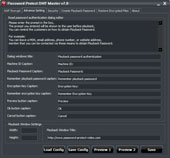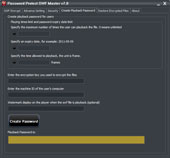Password Protect SWF Master v8.0
Password Protect SWF Master is a powerful, easy to use software for converting swf to exe. With Password Protect SWF Master Software, you can encrypt and convert swf to exe, protect swf from decompile.
How to protect swf files?
It uses a password to encrypt the swf file, then convert the swf to an exe file which can only be opened when a playback password is provided by you. Because the swf file has been encrypted, it has the ability to protect swf from decompile, prevent to extract images, videos, audios from swf files.
How to play password protected swf files?
Because the password protected swf file is encrypted by password, when a user wants to play a password protected swf file, the password protected swf file will pop up a dialog box to request the user to enter a Playback Password. This dialog box will display the machine ID of the user's computer(a unique ID for that Machine and SWF file). The user can send his/her own machine ID to you, and you can create a Playback Password based on the user's machine ID. After that the user can use this Playback Password to open your password protected swf file on his/her computer.
How to prevent SWF file sharing?
The Playback Password is created based on the user's machine ID, the user will not be able to share the Playback Password with other users. the user will not be able to redistribute your swf files, so you can protect swf from download and protect swf from decompile.
Download Password Protect SWF Master to protect swf files now.
Password Protect SWF FAQ
How to protect swf files using a password?
1. Add the swf files to the file encryption list.
2. Specify the encryption key. The files are encrypted using the encryption key, Only the person knows the encryption key can create Playback Passwords.
3. Click "Encrypt".
How to create a Playback Password for a user?
1. Specify the encryption key you used to encrypt the swf files.
2. Enter the machine ID of the computer of the user that you want to authorize.
3. Click "Create Password".
How do I know the machine ID of the user's computer?
When a user wants to play a password protected swf file, the password protected swf file will pop up a dialog box to request the user to type a Playback Password. This dialog box will display the machine ID of the user's computer. The user can send his/her own machine ID to you, and you can create a Playback Password based on the user's machine ID. After that the user can use this Playback Password to play the protected swf files on his/her computer.
How to play password protected swf files?
SWF is a Shockwave Flash application, this type of video can run on Adobe Flash players. So in order to play the password protected swf files, you need install Adobe Flash players, Adobe Flash players is free, you can download it from Adobe Offical Site.
After install Adobe Flash players, you only need to double click the protected swf file, type the playback password, then you can play the swf files.
What is the encryption key?
When encrypt swf files, you can specify an encryption key for each swf file, this software use the encryption key to encrypt the swf file. The encrypted file can only be played with a Playback Password, which can be created using the "Create Password" fucntion in the software; Only the person knows the encryption key can create Playback Password, and each Playback Password is computed using the Machine ID of the user's computer and the encryption key. The Playback Password is unique for each computer.
What is the SWF id?
Each SWF file has a unique id, the SWF id and the machine code that make up the machine id. The SWF ID is a number. When encrypt swf files, you can specify a SWF ID for each swf file, By default, the software automatically generate the SWF ID. For example You can set the same SWF ID for a series of swf files. Thus, a playback password will be able to play a series of swf files.
System Requirements
Operating System: Windows 2000/XP/2003/Vista/Win7/Win8
CPU: 1GHz Intel/AMD processor or above
Memory: 512MB memory or above
Hard Disk: 20MB or above




